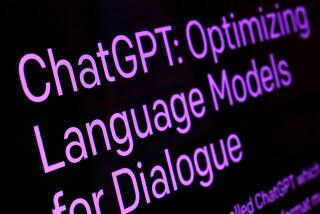Intelligence Is in the Mind of the Beholder
- Share via
How intelligent are you?
I’ll bet you would answer with at least some reference to your IQ, grade-point average, college degrees or standardized test scores.
But there’s a growing movement among educators to rethink the concept of intelligence as something more diverse than scholarly or “book” knowledge.
Promoted primarily by Howard Gardner, a professor of education at Harvard University, the theory of “multiple intelligences” holds that reading, writing and arithmetic aren’t the only kinds of intelligence we should recognize, foster and celebrate.
In fact, Gardner and his proponents say that seven kinds of intelligence exist, that they’re all equally valid and useful, and that most people are strong in at least a couple and could probably improve in all.
There’s a plethora of research on the theory of multiple intelligences, and much of it is tedious.
I’ve boiled down my reading, however, to provide a simple outline of Gardner’s intelligence categories. See where you or your child fit in.
Interestingly, only a few of Gardner’s categories of intelligence are traditionally measured in standardized tests.
Among those is, of course, linguistic intelligence. People who excel in this area can smoothly manipulate words. They can speak and write clearly and persuasively, and with a sophisticated vocabulary.
Not surprisingly, they generally read avidly and write as a second career or hobby. They often enjoy word games such as crossword puzzles, word search, tongue twisters and puns--and you’ll want them on your team for Scrabble, Taboo or other word games.
Students with strong linguistic intelligence succeed in English and history courses, maybe not in math or science. Later, they often enter careers such as journalism, law, acting or public speaking.
Logical-mathematical intelligence is also widely tested and familiar. It’s the numbers game: being able to reason, sequence and spot patterns with numbers. Such people can think in wordless yet clear images, compute numbers quickly and like to have as many things measured and categorized as possible.
Obviously they do well in math and science courses, and are ripe for careers in science, engineering, computer programming and medicine. Carl Sagan, Madame Curie and probably everyone in the NASA control room are examples of logical-mathematical intelligence to the “nth” degree.
Spatial intelligence is also recognized and tested to some extent in many students’ lives. It denotes the ability to perceive and rearrange the visual-spatial world. People in this group are good at noticing and remembering visual details, drawing or sketching accurately and thinking of new ways to arrange objects visually or spatially.
They’re often good at puzzles and other visual games (and can probably spot those trendy hidden, three-dimensional pictures that I never can). They typically have vivid dreams, a keen sense of direction in even unfamiliar places and prefer reading materials that are densely illustrated.
Architect Frank Lloyd Wright, film director Steven Spielberg and (my idol) clothing designer Donna Karan are masters of spatial intelligence.
Physical education and sports aren’t often taken seriously as types of intelligence, but Gardner implies that they should be. This category of bodily-kinesthetic intelligence includes those who have unusually good physical control.
They are adept at body movements and handling objects, generally take part in a sport or activity regularly, use plenty of hand gestures when speaking, can’t sit still for long and enjoy crafts or building things. Athletes and craftspeople fit this type.
Musical intelligence is fairly easy to define. It almost goes without saying that people with this intelligence can perceive and appreciate subtleties in music and to some degree produce melodies and rhythm.
They have a “good ear” that easily discerns off-key notes. They can sing in tune and keep time, might play an instrument, and may prove able dance partners.
Drummer Gene Krupa, opera diva Leontyne Price, pop singer k. d. lang, and choreographer George Balanchine are examples of such intelligence.
Interpersonal intelligence, in at least a small dose, is needed by everyone who does not live isolated: It is the ability to relate successfully with other people.
Masters of this type of intelligence are able to perceive and respond to people’s personalities, can organize and motivate people easily, are often sought for advice by peers, are good judges of character and are often found in leadership roles.
Such a “people person” feels comfortable in a crowd and prefers group sports or activities to more solitary pastimes.
It makes sense, then, that people with strong interpersonal intelligence do well in such careers as teaching, politics and personnel management.
Finally, there’s a category of intelligence that I believe is actually basic to all the others: intrapersonal intelligence.
It means, quite simply, knowing oneself--being aware of emotions, strengths, weaknesses, behavior patterns, goals and other character components. People who excel in this area probably spend time reflecting, meditating or exploring other means of soul-searching.
They record hallmark events and thoughts in journals, maintain clear goals, consider criticism calmly and occasionally take a hard look at their positive and negative attributes.
People in this category are often strong-willed, are unafraid of spending time alone, have strong opinions that may not be mainstream and are often self-employed.
Philosophers, social scientists and many writers generally possess and work to lead others to the kind of deep self-awareness that Gardner calls intrapersonal intelligence.
In my next column, I’ll discuss how school curricula can more thoroughly polish multiple intelligences, and how even mature adults can still improve in any of the categories.





